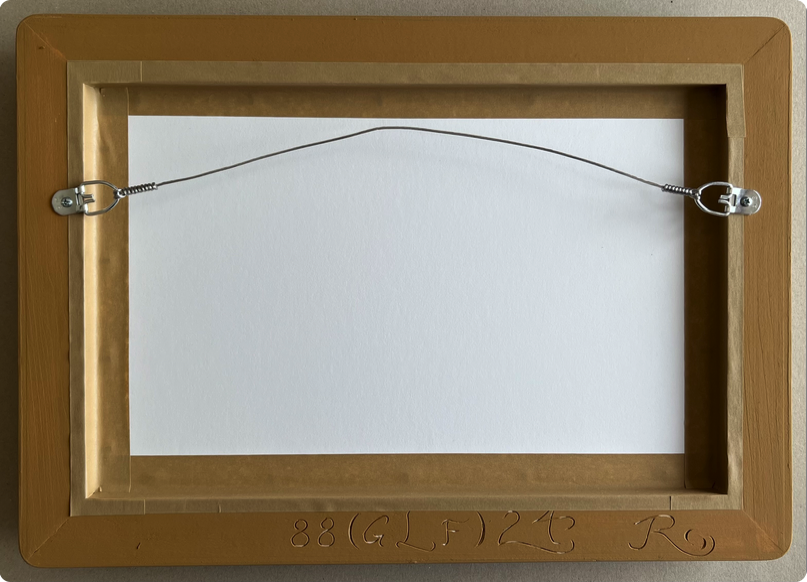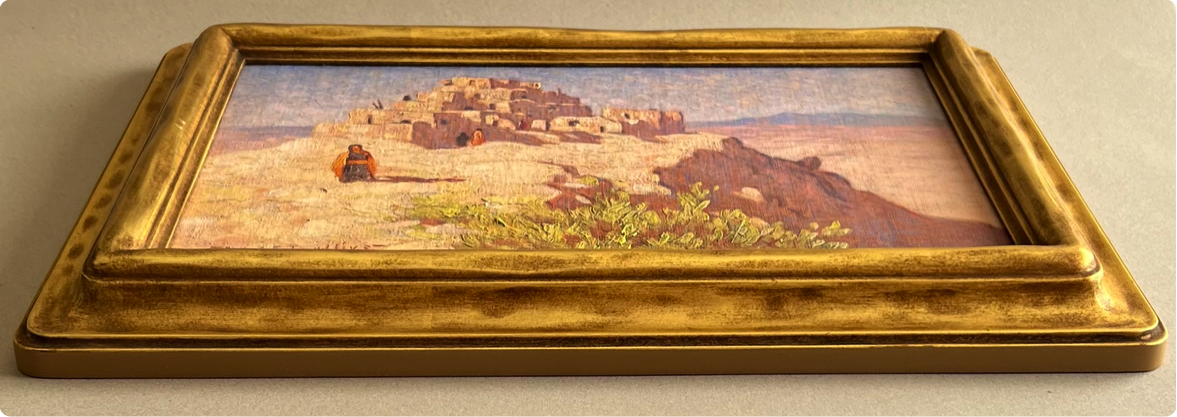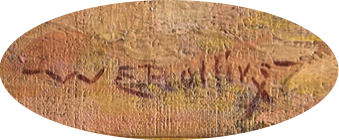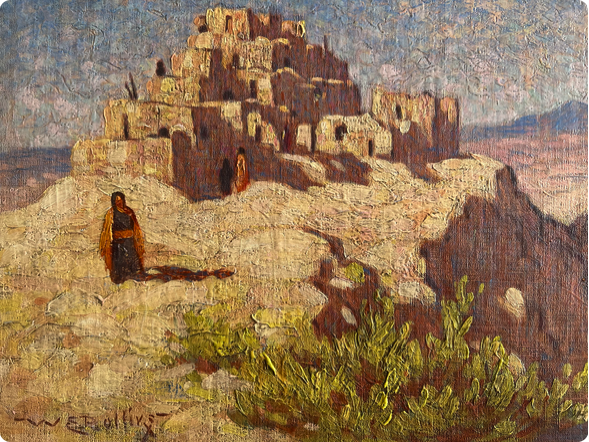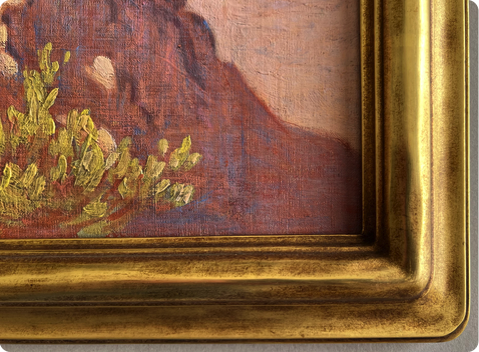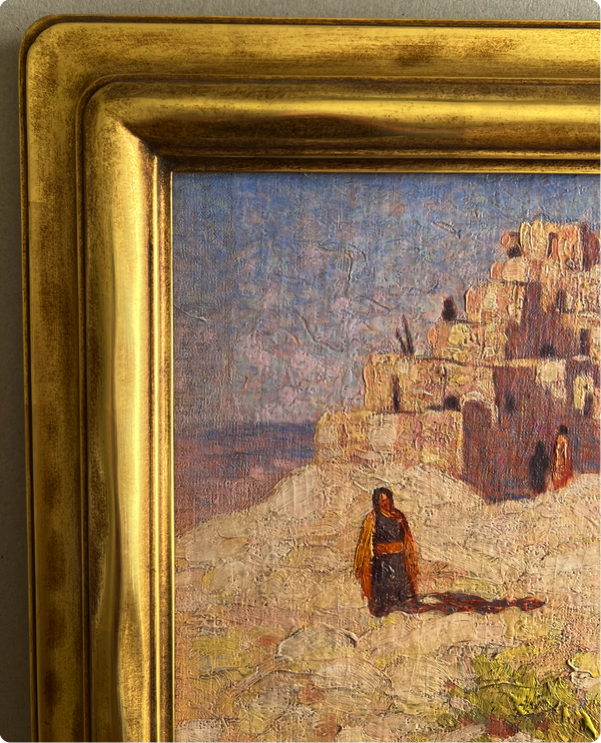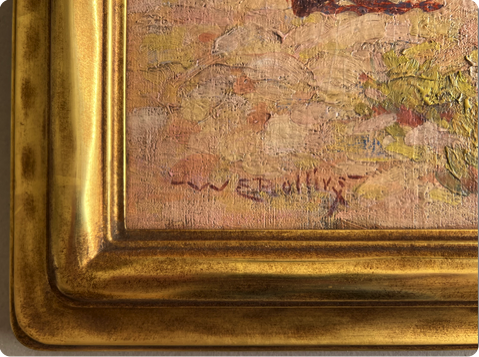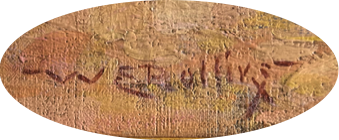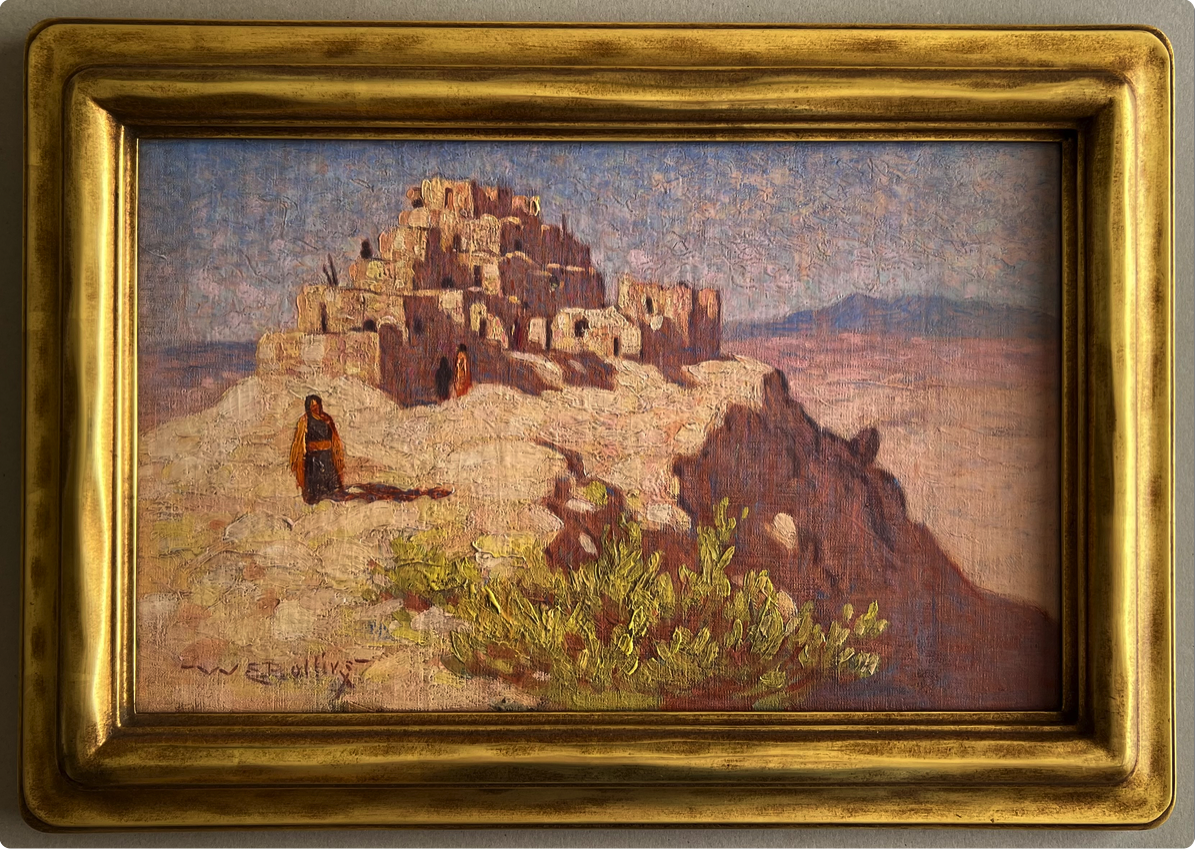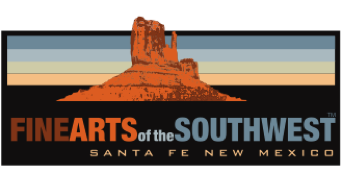
© 2010-2025 by Fine Arts of the Southwest, Inc. All rights reserved.
Unauthorized reproduction or use is strictly prohibited by law.
A wonderful early Warren E. Rollins Plein-Air painting of Walpi Village on the Hopi First Mesa,
oil on canvas, c. 1905-1915
This beautiful plein-air painting perfectly captures the timeless nature and age-old other-worldly feeling of the
ancient Hopi Pueblo village of Walpi on the Hopi First mesa. Everything about this painting is beautiful, beginning with the lovely, harmonious composition, the saturated Southwestern color palette, the sunlit rocky mesa, Indian figures silhouetted against a clear blue Western sky with hazy mountains on the far horizon, It’s a timeless and romantic evocation of a classic Southwestern scene. You get the picture.
Warren Eliphalet (W.E.) Rollins (1861-1962) originally a California native and for some time a highly-celebrated, San Diego-based California painter, is euphemistically known today in these parts as “The Dean of the Santa Fe Art Colony" which means essentially that he was the first academically-trained artist in the door here and he mounted the first-ever formal art exhibition here with the permission of the Territorial Governor. Rollins also had the finest primo studio location in town, in the old historic 17th Century Palace of the Governors smack dab in the center of the Santa Fe Plaza. Before he arrived in Santa Fe to live around 1909, Rollins had already spent years traveling extensively throughout the desert Southwest living for months at a time among the Navajo and Pueblo people painting them and their surrounding desert landscape.
Rollins traveled fairly rough in his various early 20th Century painting forays around the Southwest, on a mule or horse or in a mule or horse-drawn wagon. He cut loose canvases to size off a larger roll and after painting them, stored them stacked flat or folded or rolled for transport back to California or Santa Fe as the case was likely on the back of his pack mule or in a horse or mule drawn wagon. The fact that we discovered this painting in its original un-stretched condition is how we are fairly certain that he originally painted it on sight, or in "Plein-air", as the terminology goes. The particularly fresh and precise sun-drenched palette looking just like a bright summer day on
the Hopi mesas actually looks and feels reinforces this.
In addition to the tiny dots of inpainting in the field, there is an approximately two-inch wide swath of restoration inpainting on the viewer's right side of the canvas running from top to bottom. Our professional restorer believes this might be an indication that the canvas was once folded under itself to be framed into a smaller size framed presentation and later unfolded and touched up and restored to its full view. The total percentage of restoration/inpainting in the canvas is around 16% and this condition is clearly reflected in the price of the painting. The painting has definitely lived a life and bears a few battle scars to show for it, but its great beauty and historic integrity remains undiminished. Finally, the canvas is properly and handsomely signed "W.E. Rollins" at the lower left in the artist's characteristic and somewhat flamboyant signature.
This early classic Western American depiction of an ancient Southwestern Pueblo Indian village is the sort of iconic presentation which has made American Western painting a nearly universal and desirable vernacular the world over
and this fine painting is a perfect expression and evocation of this. This is an authentic and heartfelt piece born in the hot desert sands and rocky mesas of the American Southwest. It is at once a fine object of Western American art and
a rare and unique historic American document by one of the country's finest practitioners of Western American art.
Price $4,850

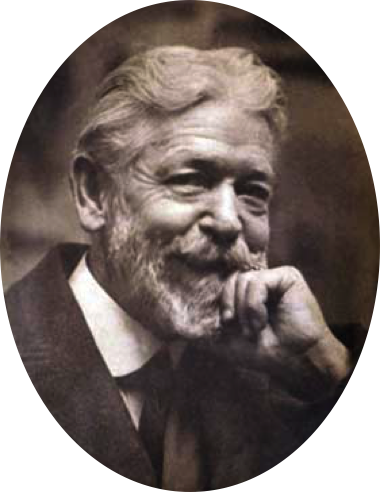
The "Dean" of the Santa Fe Art Colony,
Warren Eliphalet Rollins, c. 1910
Photo source and © warrenerollins.com
Above left, John Hillers, "Hopi Pueblo of Walpi, First Mesa, Arizona", 1876. Below, Warren E. Rollins teaching students in his art studio in Santa Fe’s Palace of the Governors, c. 1910
Left photo source and © John Hillers, 1876. Below photo source and © Palace of the Governors (MNM/DCA) Negative no: 019314
It is possible that this painting was done during that very early period, around 1905 to 1907 or it could certainly
have been done a few years later while he was headqquarted here in Santa Fe and making periodic painting trips around the Southwest. It is a bit difficult to fix the time frame exactly since not much has changed at Walpi then or in many ways since then.
The painting was done in oil on a loose un-stretched canvas (more on that in a moment) and it measures 9 1/2" in height and 15" in width (sight). The framed dimensions are 14" in height and 20" in width. We recently had the painting beautifully framed in a finely hand-carved 22K gold leaf gilded early 20th Century period-type Newcomb-Macklin Company-style frame by Goldleaf Framemakers of Santa Fe, Santa Fe’s finest fine art framers. This lovely frame is essentially a handmade work of art in its own right and it forms the the perfect presentation stage for this stunning painting.
The painting is in very good original condition particularly for its 115 or so years of age and the place and circumstances of its creation and early existence. We have had the original unstretched canvas laid down on an Archival Beva board panel by our excellent professional painting restorer who also cleaned and freshly varnished
the painting. The painting has some areas of restoration inpainting. There are a number of older tiny dots of inpainting
in the main body of the painting, possibly resulting from the canvas having been rolled or stacked for transport by Rollins himself and then touched up by him later.
